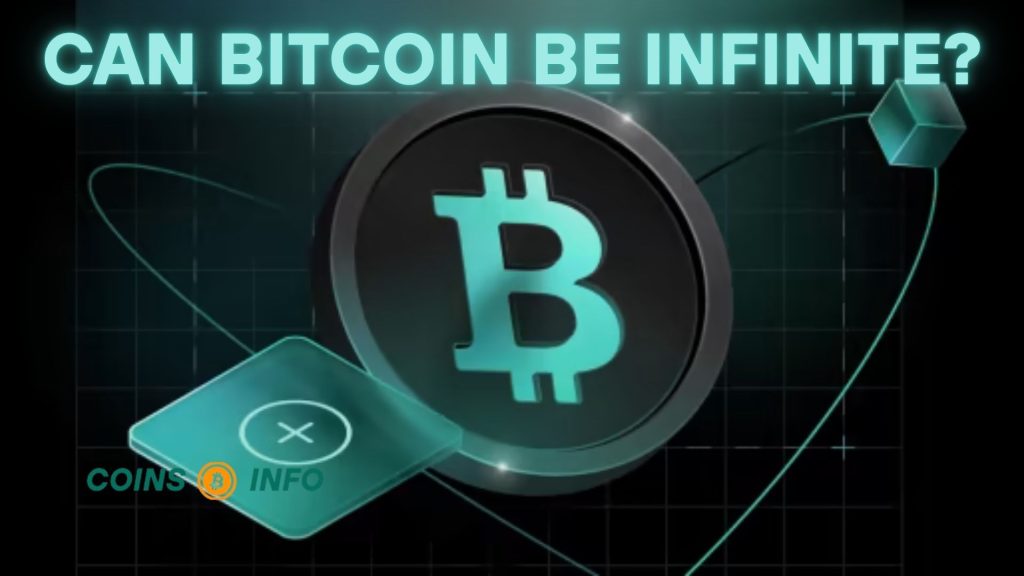Can Bitcoin Be Infinite? With its promise of decentralized banking and digital ownership, Bitcoin, the first and most well-known cryptocurrency, has enthralled people all over the world. The fixed supply of Bitcoin is one of its most important and distinctive features. Bitcoin cannot be printed indefinitely, in contrast to conventional currencies that are issued by governments. The debate of whether Bitcoin can be infinite arises from this basic feature. In a nutshell, no, because Bitcoin is meant to be limited. But a closer examination of this design’s subtleties and repercussions is warranted.
The Fixed Supply of Bitcoin.
A constraint that restricts the total number of bitcoins that will ever exist—21 million—is at the heart of the cryptocurrency’s architecture. The network of nodes and miners that uphold the blockchain enforces this cap, which is hardcoded into the source code of Bitcoin. This implies that the total number of bitcoins in circulation can never exceed 21 million.
In order to simulate limited resources like gold and avoid inflation, which is a common problem with fiat currencies, Bitcoin’s creator, Satoshi Nakamoto, implemented this cap. The ability of central banks to print more money at will in fiat systems frequently results in depreciation. Bitcoin is a deflationary asset over time because of its limited supply, which guarantees that its scarcity endures.
How Are Bitcoins Created?
Mining is the method by which new bitcoins are created. Miners solve intricate mathematical puzzles and verify transactions using powerful computers. Miners get a block reward, or a specific quantity of freshly produced bitcoins, for each block of transactions that are added to the blockchain.
This reward isn’t consistent, though. It goes through a process known as halving roughly every 210,000 blocks, or every four years. The first reward was 50 Bitcoins per block in 2009. 2012 saw a halving to 25 BTC, followed by 12.5 BTC in 2016 and 6.25 BTC in 2020. As of the 2024 halving, the reward is 3.125 BTC. This pattern persists until around 2140, when there will be no more bitcoins produced, and the reward will be close to zero.
Why Bitcoin Cannot Be Infinite.
There are several reasons why Bitcoin cannot and will not be infinite:
- Mathematical Cap: The 21 million cap is embedded in the Bitcoin protocol. Changing this would require a network-wide consensus—a near-impossible feat, especially given how many people benefit from Bitcoin’s scarcity.
- Economic Principles: Scarcity drives value. If Bitcoin were infinite, its value would likely drop significantly, similar to how overprinting fiat currency leads to inflation and loss of purchasing power.
- Community Consensus: The global Bitcoin community—including developers, miners, investors, and users—is heavily invested in maintaining the fixed supply. Any proposal to increase the cap would likely face massive resistance.
- Network Integrity: Changing the cap would require a hard fork—a split in the network. This would lead to major disruption, confusion, and loss of trust. It could also result in two separate coins, as has happened in the past with Bitcoin Cash.
Could Bitcoin Be Made Infinite in Theory?
Theoretically, yes, provided that the protocol change was accepted by the majority of the network. However, in reality, it is highly improbable. By doing this, Bitcoin’s distinctive value proposition—its predictable, restricted supply—would be compromised.
Furthermore, even if such a change were suggested, it would probably divide the community and result in two chains: one with the updated cap and one with the original 21 million cap. The original chain typically maintains the most value and credibility, according to history.
Infinite Divisibility Instead of Infinite Supply.
It is crucial to distinguish between divisibility and supply. Each bitcoin is easily divisible, despite the fact that its quantity is limited. 100 million satoshis, which are named after Satoshi Nakamoto, can be created from one bitcoin. This implies that the network can handle trillions of transactions utilizing tiny fractions of a bitcoin, even if all 21 million are mined.
Because of its divisibility, Bitcoin can be used even while its value rises. For instance, users could still transact in small quantities like 0.0001 BTC ($100) even if one bitcoin was worth $1 million.
Conclusion.
It is unlikely that Bitcoin will ever be limitless, as it was never intended to be. A key component of its value and identity is its fixed supply of 21 million coins. Because of its scarcity, it differs from fiat money and has the characteristics of “digital gold.” Although wide adoption and flexible use are made possible by unlimited divisibility, the overall quantity of bitcoins is limited by design.
There would be strong community, ideological, and technical opposition to any attempt to amend this rule. Because of this, one of the most dependable parts of the cryptocurrency market is still Bitcoin’s hard cap. This limited supply, rather than being a constraint, is what makes Bitcoin a potent store of wealth in a financial environment that is becoming more unpredictable.
